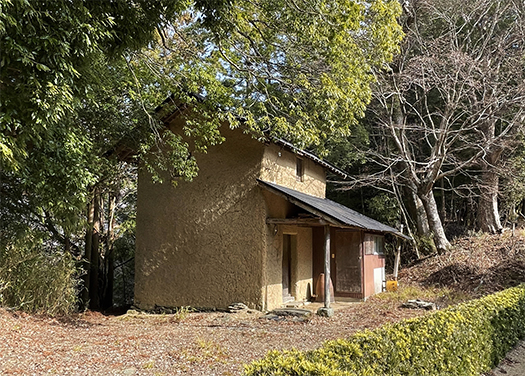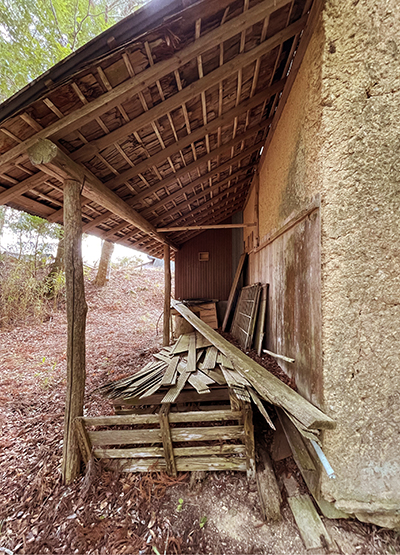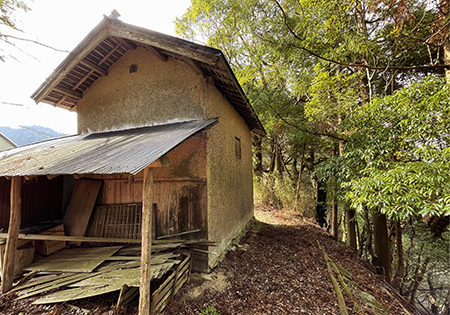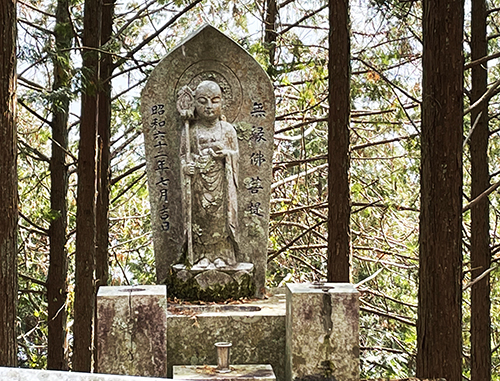


建築のありようとして、その目的が明確にこころに刺さってくる三木家住宅。古代あるいは上古以来の悠久な時間を感じる山上の空間ですが、ご紹介する建物は本屋の裏手、すぐにも崖が迫っている境界に建てられた倉庫目的と思えるもの。いかにも用の建築であることがわかる。裏手側にはさまざまな麻材生産のためとおぼしき用材が無造作に置かれている。
しかしそういう建築であるのに、土塗り壁が重厚に重ねられてかなりの壁厚を見せている。土蔵建築というのはその収用物が貴重品であることと、防火性・断熱性を重視した伝統建築。重要文化財指定された古建築だけれど、この土蔵についての記録は参照できませんでした。また、本屋同様施錠されていて内部を見ることもできなかったので、あくまでも想像ですが、用途は朝廷に調進する麁服(あらたえ)の生産に役立てられた用の建築なのだろうと思える。
開口部は入口を除けば、4方向に小さな通風・採光の限定要素の小窓があるだけ。
塗り込められた土壁の手ざわり感が独特の陰影感を見る者に訴求してくる。わたしはコンクリートブロックと煉瓦の家に住んでいますが、こういう伝統的な断熱建築には強いシンパシーを感じる。建築目的において昔人の必死の思いのようなものが伝わってくる。それは本州地域の日本人がようやく最近、150年前くらいから北海道に住み始めて以降の、生存環境への必死さと民族としてどこかでつながるものを感じるからだと思っている。


土蔵建築は防火性があって都市内での伝統家屋付属建築は、それが主たる目的で断熱性・気密性は付随的に得られたと思えるのですが、しかしこの建物は防火が主目的とは思われない。やはり麁服の謹製工程での必要な環境要件だっただろうと推測できる。先日も紹介したインタビュー記事ではこの麻生産の労苦も語られていた。「麻は法律で栽培が制限されていることもあり、管理も大変だ。私が担当した前回(の『大嘗祭』)は麻を育てる畑を24時間警備しなければならなかった。こうした人件費を含めて『麁服』調進にかかる費用は数千万円になる。徳島の企業や人に広く寄付を募っており、これが地元の関心が高まるきっかけになればと期待している」
こうした日本の民族性に深く関わる古代からの古格な伝統を、いまでも守り続けるという意思には深くリスペクトさせられる。記事ではまだ若い世代のお孫さんがこの伝統を継ぐ決意をされているとのこと。現代社会でもむしろ若い年代のみなさんの方が、こういう伝統性の意義を深く理解していると感じる。その意味で社会はどのように適応すべきか、深く考えさせられた。末尾の写真の仏像は帰り道の路傍に建てられていたものだけれど、つい合掌させられていた。 <徳島・三木家住宅記おわり>
English version⬇
Earthen storehouse of neat appearance and beauty The Miki Family Residence in Tokushima, Japan – 5
The younger generation has the will to carry on the core culture of the Japanese people, the “aritae” or “clothes” style of dress. How should we create the future? Tokushima, Japan
The Miki family’s residence clearly conveys the purpose of architecture. The building we will introduce here was built behind the bookstore on the boundary of a cliff that is immediately in front of the house, and seems to have been built for storage purposes. It is clear that it is an architectural structure for this purpose. On the back side of the building, various hemp materials that seem to have been used for hemp production are randomly placed.
Despite the fact that the building is a storehouse of this kind, the mud-painted walls are heavily layered, showing a considerable wall thickness. The earthen storehouse is a traditional building that emphasizes fireproofing and heat insulation, as well as the fact that the objects stored in the storehouse are valuable. Although it is an old building designated as an important cultural property, I could not find any record of this storehouse. I could not see the inside of the storehouse because it was locked, just like the bookstore, so I can only guess that it was used to produce clothes for the Imperial Court.
Except for the entrance, there are only small windows in four directions for limited ventilation and lighting.
The texture of the painted clay walls appeals to the viewer with its unique shading. Although I live in a house made of concrete blocks and bricks, I feel a strong sympathy for this kind of traditional insulated architecture. It conveys the desperate desire of the people of the past for the purpose of construction. I believe this is because I feel a connection somehow as a people with the desperation of the Japanese people in the Honshu area to survive in the environment since they finally began to live in Hokkaido about 150 years ago.
It seems to me that storehouse construction is fireproof and traditional house accessory construction within a city would have had that as its primary purpose, with insulation and airtightness obtained incidentally, but this building, however, does not seem to have fireproofing as its primary purpose. It can still be assumed that it would have been a necessary environmental requirement for the respectful manufacturing process of clothes. The interview article I mentioned earlier also discussed the laborious process of producing this hemp. The cultivation of hemp is restricted by law, and it is also very difficult to manage. The last time I was in charge of the “Omame Festival,” we had to guard the fields where hemp was grown 24 hours a day. Including these labor costs, the cost of the “clothes-garment” preparation is in the tens of millions of yen. We are soliciting donations from a wide range of businesses and people in Tokushima, and we hope that this will trigger an increase in local interest.
I deeply respect the will to continue to preserve this ancient tradition, which is deeply related to the Japanese ethnicity. The article states that his grandchildren, who are still in the younger generation, are determined to carry on this tradition. I feel that even in today’s society, the younger generation has a deeper understanding of the significance of this kind of tradition. In this sense, it made me think deeply about how society should adapt itself. The Buddha statue in the photo at the end of this article was erected on the roadside on my way home, and it made me clasp my hands in prayer.
Posted on 1月 29th, 2023 by 三木 奎吾
Filed under: 住宅取材&ウラ話, 歴史探訪







コメントを投稿
「※誹謗中傷や、悪意のある書き込み、営利目的などのコメントを防ぐために、投稿された全てのコメントは一時的に保留されますのでご了承ください。」
You must be logged in to post a comment.